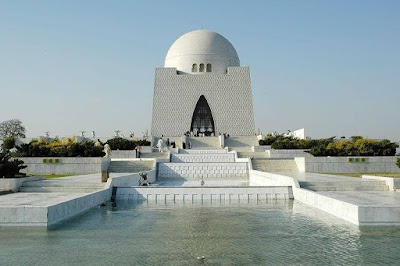karachi is famous for (city of light). karachi city is the capital of sindh province. it is the largest city in pakistan and 12 largest city in the world. karachi is the back bone of pakistan economy.karchi is also know as a bussines hub and financial center of pakistan.karachi is located on the coast of ARABIAN SEA.
immediately is the north of indus river.karachi is the metropolitan city of pakistan. the oldest name of karachi is kalachi in 1960 karachi grow fastly. one of those input to the country over all tax revenue.
karachi generate 65% pakistan revenue.if the mertropolite security situation improve the can be better economics prospects for every one.
the sindhi name of karachi is caranjee, kuruchi ,cruchy all its name believed to b derived.after part
40% people come from inida and call him self mahajor. karachi is also called mini pakistan all tribe of people live togather like pashtoon, mahajer ,sindhi , balochi , siraiki , punjabi , chitaraly , gilgati , kashmeri , bengali etc
the development of air travel is subsequently increased karachi importance . area of the city 228 square miles. greater karachi 560 square miles.
karachi is also famous for sufi buzarag
City layout:
The most striking aspect of Karachi’s layout is the west-to-east parallel alignment of the four arterial roads—Nishter Road (formerly called Lawrence Road), Mohammed Ali Jinnah Road (formerly Bandar Road), Shahrah-e-Liaquat (Frere Road), and I.I. Chundrigar Road (McCleod Road). Beginning at Mereweather Tower in the vicinity of the port, these roads run through the centre of the city. Several roads, such as Napier Road, Dr. Zia-ud-din Ahmed Road (Kutchery Road), and Garden Road, cut perpendicularly across these arteries from north to south.
The old town lies near the port, to the north of M.A. Jinnah Road, and with extensions stretching along the material roads for over a mile; unplanned, it is reminiscent of medieval towns of the Middle East or Europe. East of the old town are such districts as the Drigh Cantonment, the Civil Lines (residential areas for senior civil service officers), and the Saddar Bazar. This area is planned on a checkerboard pattern and shows European characteristics. Beyond this stretch several radial roads, along which growth has taken the form of neighbourhood units; each unit is laid out with straight, broad roads connected by smaller streets.
The land-use pattern of the city is complex. In the central area, the preponderance of residential property tends to form a matrix within which all other functions are distributed. There is, however, a marked concentration of commercial buildings at the western ends of M.A. Jinnah Road and I.I. Chundrigar Road. Wholesale businesses are located in the old town, retail businesses along M.A. Jinnah Road and in Saddar Bazar, and the government offices on Shahrah-e-Liaquat, near Saddar. The outer areas are dominated by dormitory suburbs interspersed with a scattering of cantonments (military quarters), agricultural tracts, saltworks, airports, railway stations, and marshaling yards.
The city proper has old and decayed buildings, occupied by members of the middle and lower income groups. Farther from the city centre are modern bungalows occupied by richer persons; the outer zone is occupied by workers.
Karachi has a variety of types of buildings. The central area contains apartment bungalows, barracks, and multistoried buildings; the outer areas are characterized by bungalows, blocks of flats, and quarters (streets of small houses). Buildings of the British period were constructed with stone in Western styles of architecture; other stone buildings in the central city show a blending of Eastern and Western styles and have towers, domes, pillars, arches, hanging balconies, and rectangular courtyards. Buildings in the outer areas are built of cement blocks, and with few exceptions they show no uniformity in design. Some follow contemporary North American design, while others incorporate features of traditional Muslim architecture.
INDUSTRY:
Textiles and footwear are the principal items manufactured, followed by such items as metal products, food and beverages, paper and printing, wood and furniture, machinery, chemicals and petroleum, leather and rubber, and electrical goods. Karachi is also an important centre for handicrafts and cottage industries that produce handloomed cloth, lace, carpets, articles made of brass and bell metal (an alloy of copper and tin), pottery, leather goods, and gold and silver embroidery. Karachi handles the entire seaborne trade of Pakistan.
FINANCE:
There are more than 25 banks in Karachi that have branches throughout Pakistan; these include the State Bank of Pakistan, the Habib Bank Ltd., the National Bank of Pakistan, the United Bank Ltd., the Industrial Development Bank of Pakistan, and the Agricultural Development Bank of Pakistan. The city is also the centre of about two dozen insurance companies, which play an important role in the economic development of the country by investing large sums in power development, housing programs, joint-stock companies, government loan securities, and savings certificates. pakistan stoke exchange is also in karachi.
EDUCATION:
Karachi has more than 900 schools, of which the majority are primary schools and the rest are secondary schools. More than half of all these are privately run, the rest being run by the government. Among schools established by different religious communities are Karachi Grammar School, St. Joseph’s Convent School, and St. Patrick’s High School, all of which are Christian; a school for the Parsi community; and Sindh Madrassa, a Muslim school.
The University of Karachi is the primary institution of higher education. It has more than 20 graduate departments in arts and sciences, as well as a graduate school of business administration. Courses in a variety of subjects, including commerce and law, are provided by about 75 colleges affiliated to the university. In addition, there is a medical college, as well as two engineering colleges, a polytechnic institute, a college of home economics, and two teacher-training colleges.




0 Comments